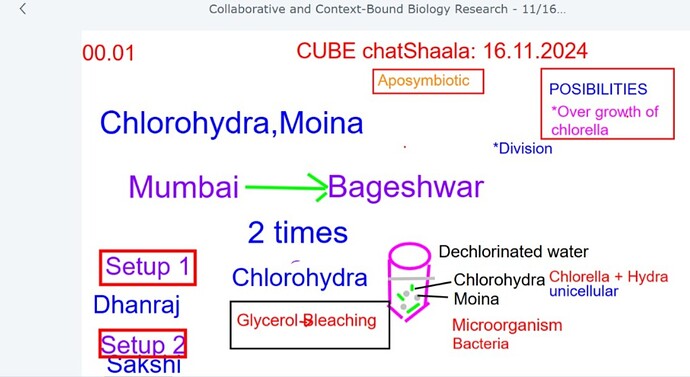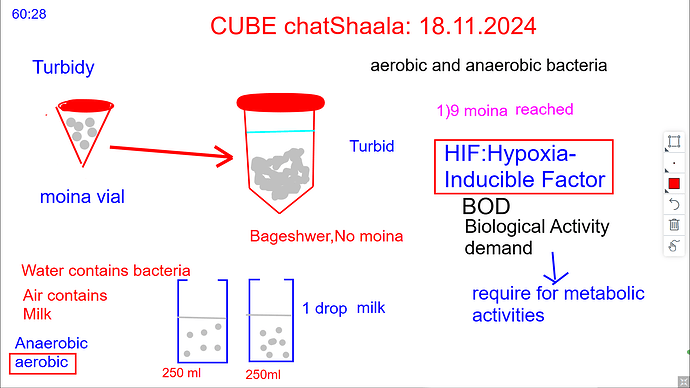What did Alexander Fleming do when he first saw the bacterial petri plate after returning from vacation
Did he throw it away? If he did, someone else might have discovered antibiotics like penicillin, or such a breakthrough moment wouldn’t have happened at all!?
We seem to have a similar moment . There are Chlorohydra and Moina samples sent from Mumbai to Bageshwar by
According to the story I know from Kiran, in the first attempt,now there were no Moina or Chlorohydra observed.
In the second setup, sent by Sakshi, the Chlorohydra are still present, but no Moina are observed.
What can we do with the water containing the vials? Can we expect to find sexual eggs of Moina and Chlorohydra? I hope we haven’t discarded them and that we can critically analyze it?
What do others think? Is it possible that sexual eggs could be produced in the vials due to unfavorable conditions?
Returning from holiday on September 3, 1928, Fleming began to sort through petri dishes containing colonies of Staphylococcus, bacteria that cause boils, sore throats and abscesses. He noticed something unusual on one dish. It was dotted with colonies, save for one area where a blob of mold was growing.Alexander Fleming Discovery and Development of Penicillin - Landmark - American Chemical Society
Chatshaala discussions:
1)
Tinke moment
Asymbiotic hydra :chlorohydra without chlorella
Sexual reproduction in hydra:
Hydras usually reproduce asexually by “budding”—a new hydra starts as a “bud” forming on the side of a hydra’s body; it grows and eventually breaks away as a clone of the original. Some species reproduce sexually, releasing sperm into the water that can reach eggs on another hydra. Hydras | Missouri Department of Conservation.
It has been shown that hydra which are kept in the light, but otherwise starved, survive better than hydras without any green algae inside them. They are also able to survive in water with a low dissolved oxygen concentration because the algae supply them with oxygen. This oxygen is a by product of the photosynthesis carried out by the algae. Green hydra transmit the algae from one generation to the next in the eggs."
http://www.countrysideinfo.co.uk/hydra.htm
Aposymbiotic H. viridissima were first described by Whitney (1907), but this condition has never been recorded in nature (Bossert and Dunn, 1986). Pardy (1983) reported that culturing H. viridissima in a medium containing glycerol resulted in the ejection of their algae so that the polyps became “bleached.” However, these aposymbiotic Hydra survived and reproduced as well as symbiotic animals, providing they were fed regularly (Muscatine and Lenhoff, 1965). https://www.sciencedirect.com/science/article/abs/pii/S0147651304000557
Intracellular infection of aposymbiotic Hydra viridis by a foreign free-living Chlorella sp.: initiation of a stable symbiosis. Intracellular infection of aposymbiotic Hydra viridis by a foreign free-living Chlorella sp.: initiation of a stable symbiosis - PubMed
Sexual reproduction in Hydra
Hydra reproduces sexually by the fusion of gametes when the environmental condition becomes unfavorable (generally in autumn).
Factors such as changes in temperature (low temperatures) and the lack of sufficient food sources cause the organism to start developing gonads in preparation for sexual reproduction. Hydra- Reproduction (Budding and Sexual), Regeneration, Immortality.
2)
Hypoxia inducible factor, a transcription factor responsible for producing more hemoglobin to overcome less oxygen availability.
2019 Nobel prize
The 2019 Nobel Prize in Physiology or Medicine was awarded to William G. Kaelin Jr., Sir Peter J. Ratcliffe, and Gregg L. Semenza for their discovery of hypoxia-inducible factor, a key transcription factor that regulates gene expression in response to decreases in cellular oxygenation.
HIF(Hypoxia inducing factor),Transcription factor >EPO gene>Erythropoietin(Kidney)>Bone marrow>Erythropoiesis>RBC cells>Hemoglobin synthesis .,Photo:Hypoxia Pathway Proteins are Master Regulators of Erythropoiesis
3)
Highlights of the discussion:
sexual and asexual way of reproduction in moina
In unfavorable conditions moina can produce sexual eggs.
In cold water conditions or when food is sparse, the hydra forms testes and ovaries for sexual reproduction. Hormones are produced and the hydra becomes a hermaphrodite. Eggs develop and attach to the body wall. After the eggs are fertilized, they eventually harden and fall off.Hydra Definition, Nervous System & Reproduction | Study.com.
From a study of over 1000 mothers, the female chromosome number appears to be 2N = 22; N = 11. The male number has not been exactly determined, but is presumably not haploid. Only one maturation division occurs in the parthenogenetic egg, and the authors have seen only one in the sexual egg.https://www.researchgate.net/publication/229992534_Growth_and_maturation_in_the_parthenogenetic_and_sexual_eggs_of_Moina_macrocopa
CONTEXT TO CURRICUM WHATSAPP GROUP DISCUSSIONS:
[18/11, 5:14 PM] Himanshu Joshi: Were any red colored Moinas present in the vials when @Kiran CUBE recieved it from Sakshi after a week’s time
[18/11, 5:16 PM] Arunan Sir: Good question, after a long time. Can @Kiran CUBE tell us more on and let’s all join in discussion.
Thanks @Himanshu Joshi
[18/11, 5:17 PM] Himanshu Joshi: If eggs of Moinas present in the vials even now, then How the Moinas would survive in less oxygen containing water after hatching
@Theertha @Kiran CUBE
Don’t we have to add some more water to make the condition of vials better
[18/11, 5:22 PM] Batul : Has no water been added to the original solution received by you?@Kiran CUBE
[18/11, 5:43 PM] Himanshu Joshi: @Kiran CUBE Did you find any red Moina in the Moina vial sent to you by @Sakshi
[18/11, 5:46 PM] Himanshu Joshi: How does addition of more water to original solution help Kiran in getting Moinas hatched from sexual eggs if there are any @Batul Mam
[18/11, 5:57 PM] Himanshu Joshi: Can we connect this with the current model systems sent to Kiran at Bhageshwar from Mumbai
[18/11, 6:21 PM] Theertha: Have you noticed any red moina ,when you got the vials? @Kiran CUBE , if you have the video please share
[17/11, 9:16 PM] Batul : 2019 Nobel prize winning work
[17/11, 9:37 PM] Chithra : No mention of HIF in regulating expression of haemoglobin genes in humans; regulates expression of genes involved in angiogenic vascularisation, proteasomal degradation etc.
[17/11, 9:41 PM] Theertha: Humans have adapted to the chronic hypoxia of high altitude in several locations, and recent genome-wide studies have indicated a genetic basis. In some populations, genetic signatures have been identified in the hypoxia-inducible factor (HIF) pathway, which orchestrates the transcriptional response to hypoxia.Human high-altitude adaptation: forward genetics meets the HIF pathway - PMC.
[17/11, 9:45 PM] Chitra : Yes, HIF is involved in enhancing erythropoietin formation which in turn stimulates RCB production from bone marrow.
[17/11, 9:46 PM] Chitra Ma’am: And doesn’t enhance expression of haemoglobin genes.
[17/11, 9:48 PM] Chitra Ma’am: In humans





